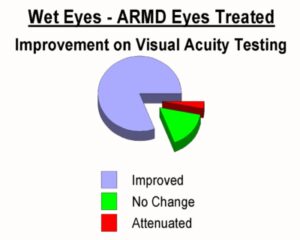Appendix: Results from the First 120 People Treated
Results
 Of all 120 patients treated, 83% (101/120) showed improvement of greater than or equal to two lines of visual acuity in one or both eyes. If we include those who had at least one line of improvement in visual acuity, then 93% showed improvement.
Of all 120 patients treated, 83% (101/120) showed improvement of greater than or equal to two lines of visual acuity in one or both eyes. If we include those who had at least one line of improvement in visual acuity, then 93% showed improvement.
There were 11 patients (11 of 120) with Stargardt Disease who were treated and of these all 11 or 100% showed an improvement of greater than or equal to two lines of visual improvement in one or both eyes. There was one patient (1of121)who had the diagnosis of X-linked Retinoschisis and they also showed two lines of improvement on visual acuity testing in both eyes.
If we take the 109 patients with Age Related Macular Degeneration (ARMD) and break them down by diagnosis type into exudative (wet) and non-exudative (dry) we find that of the patients with wet ARMD 88% (43/49) showed an improvement of two lines or greater on visual acuity testing and of those with dry ARMD, 77% (46/60) showed improvement of two lines or more on visual acuity testing.
Check out the PDF report HERE
Most patients with Macular Degeneration show variation in the time of onset and the progression of the disease between their two eyes. Many of the patients who have the wet or exudative form of the disease have only had problems with leaking or bleeding in one eye and not the other while some have shown evidence for leaking or bleeding in both eyes. Two patients were blind in one eye for reasons entirely unrelated to their Macular Degeneration. For these and other reasons, we also present the data below in terms of the number of eyes treated. This gives a better sense of the differential response between those eyes with the exudative (wet) form of Macular Degeneration and the response of those eyes with the non-exudative (dry) form of Macular Degeneration.
The data is presented in terms of improvement expressed as “lines of visual acuity”. This refers simply to the lines on the eye chart that you read as part of an eye exam. If someone shows improvement of, for example, “three lines of visual acuity”, it means that they could read three lines more down the eye chart after treatment than they could before treatment. Two lines of improvement or change on a visual acuity exam is necessary to call a result clinically significant. If the person’s vision is improved by two lines or more as measured in visual acuity testing, this is significant, and not due to random fluctuation.
Results Reported by the Number of Eyes Treated:
By doing some simple arithmetic on the data, we find that of the eyes treated, the total for all eyes with non-exudative disease was 36% with an improvement of three lines or greater on a visual acuity test and for those with exudative disease, 53% showed improvement of three lines or greater on visual acuity testing following treatment. The patients who had greater than or equal to four lines of improvement on visual acuity testing was also quite gratifying with 22% improving with the dry form of the disease and 32% improving with the wet form of the disease. To put this in perspective, if your best corrected vision is now 20/150, an improvement of three lines of visual acuity might be enough improvement to pass the exam for a driver’s license. We have indeed had numerous people who have improved enough from the therapies to regain their driver’s license.
In the limited data reported in conferences by others doing this work (Halloran 1997, Jarding 1997) there had been evidence for significant slowing and stopping of the progression of disease in those treated and followed over many years. If there was improvement as the result of treatment, this improvement was maintained, and even where there was no significant improvement, the vision stabilized and the stabilization persisted as long as treatment was continued. If all these therapies did was to stop the progression of the disease, they would be worth doing.
Again for more details on the results you can download a PDF of the information HERE.
